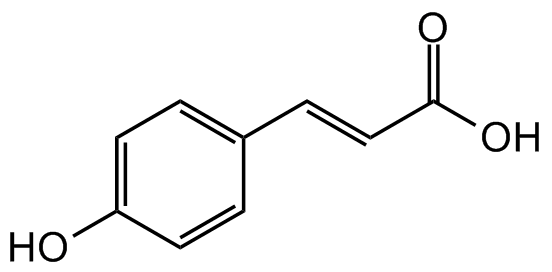p-Coumaric acid
| Code | Size | Price |
|---|
| CDX-C0400-G010 | 10 g | £48.00 |
Quantity:
| CDX-C0400-G025 | 25 g | £72.00 |
Quantity:
Prices exclude any Taxes / VAT
Overview
Host Type: Plant
Regulatory Status: RUO
Shipping:
AMBIENT
Storage:
+4°C
Images
Documents
Further Information
Alternate Names/Synonyms:
para-Coumaric Acid; trans-p-Coumaric Acid; trans-4-Hydroxycinnamic acid; (E)-3-(4-Hydroxyphenyl)prop-2-enoic acid
Appearance:
White to off-white powder.
CAS:
501-98-4
EClass:
32160000
Form (Short):
liquid
GHS Symbol:
GHS07
Handling Advice:
Protect from light and moisture.
InChi:
InChI=1S/C9H8O3/c10-8-4-1-7(2-5-8)3-6-9(11)12/h1-6,10H,(H,11,12)/b6-3+
InChiKey:
NGSWKAQJJWESNS-ZZXKWVIFSA-N
Long Description:
Chemical. CAS: 501-98-4. Formula: C9H8O3. MW: 164.16. p-Coumaric acid is mainly a plant metabolite which exhibits antioxidant, antimicrobial, antitumor, antiangiogenic, antidiabetic, antihyperlipidemic, neuroprotective and anti-inflammatory properties. It shows bactericidal/quorum sensing activity by damaging bacterial cell membrane and by interacting with bacterial DNA. It prevents metabolic syndromes through the activation of brown adipose tissue (BAT), linked to UCP1 upregulation, with accelerated burning of fatty acids and glucose, leading to enhanced the energy expenditure and thermogenesis. Also used in proteomics, e.g. in western blot, p-coumaric is used as an enhancer in chemiluminescent substrates. Used in cosmetics as a skin-lightening compound, due to its antimelanogenic effects, based on its potent competitive inhibition of tyrosinase.
MDL:
MFCD00004399
Molecular Formula:
C9H8O3
Molecular Weight:
164.16
Package Type:
Vial
Precautions:
P302 + P352 - P305 + P351 + P338
Product Description:
p-Coumaric acid is mainly a plant metabolite which exhibits antioxidant, antimicrobial, antitumor, antiangiogenic, antidiabetic, antihyperlipidemic, neuroprotective and anti-inflammatory properties. It shows bactericidal/quorum sensing activity by damaging bacterial cell membrane and by interacting with bacterial DNA. It prevents metabolic syndromes through the activation of brown adipose tissue (BAT), linked to UCP1 upregulation, with accelerated burning of fatty acids and glucose, leading to enhanced the energy expenditure and thermogenesis. Also used in proteomics, e.g. in western blot, p-coumaric is used as an enhancer in chemiluminescent substrates. Used in cosmetics as a skin-lightening compound, due to its antimelanogenic effects, based on its potent competitive inhibition of tyrosinase.
Purity:
>98% (HPLC)
SMILES:
OC1=CC=C(/C=C/C(O)=O)C=C1
Solubility Chemicals:
Soluble in ethanol (30 mg/ml), DMSO (15mg/ml) or DMF (20mg/ml).
Source / Host:
Plant
Transportation:
Non-hazardous
UNSPSC Category:
Natural Products/Extracts
UNSPSC Number:
12352200
Use & Stability:
Stable for at least 2 years after receipt when stored at +4°C.
References
(1) C. Luceri, et al.; Br. J. Nutr. 97, 458 (2007) | (2) C. Haan & I. Behrmann; J. Immunol. Meth. 318, 11 (2007) | (3) S.F. Bodini, et al.; Lett. Appl. Microbiol. 49, 551 (2009) | (4) D. Dolores & C.Y. Cheng; Spermatogenesis 1, 121 (2011) | (5) D. Stojkovic, et al.; J. Sci. Food Agric. 93, 3205 (2013) | (6) S.J. Pragasam & M. Rasool; Inflamm. Res. 62, 489 (2013) | (7) S.J. Pragasam, et al.; Inflammation 36, 169 (2013) | (8) C.S. Kong, et al.; Phytother. Res. 27, 317 (2013) | (9) S. Shailasree, et al.; Mol. Neurobiol. 51, 119 (2015) | (10) V. Amalan, et al.; Biomed. Pharmacother. 84, 230 (2016) | (11) K. Pei, et al.; J. Sci. Food Agric. 96, 2952 (2016) (Review) | (12) A. Abdel-Moneim, et al.; Biomed. Pharmacother. 105, 1091 (2018) | (13) S.H. Sharma, et al.; Chem. Biol. Interact. 291, 16 (2018) | (14) R. Sakamula, et al.; Metab. Brain Dis. 33, 765 (2018) | (15) Y.C. Boo; Antioxidants 8, 275 (2019) (Review) | (16) X. Hu, et al.; Front. Oncol. 10, 558414 (2020) | (17) X. Han, et al.; FASEB J. 34, 7810 (2020) | (18) M.F. Abazari, et al.; Mini Rev. Med. Chem. (epub ahead of print) (2021) (Review)



